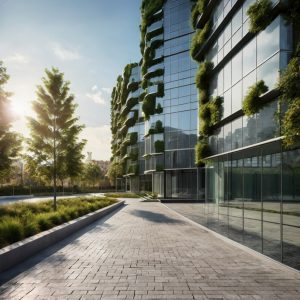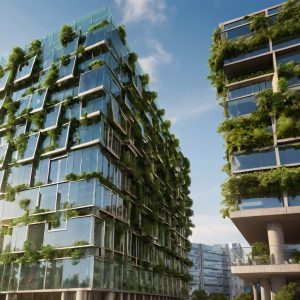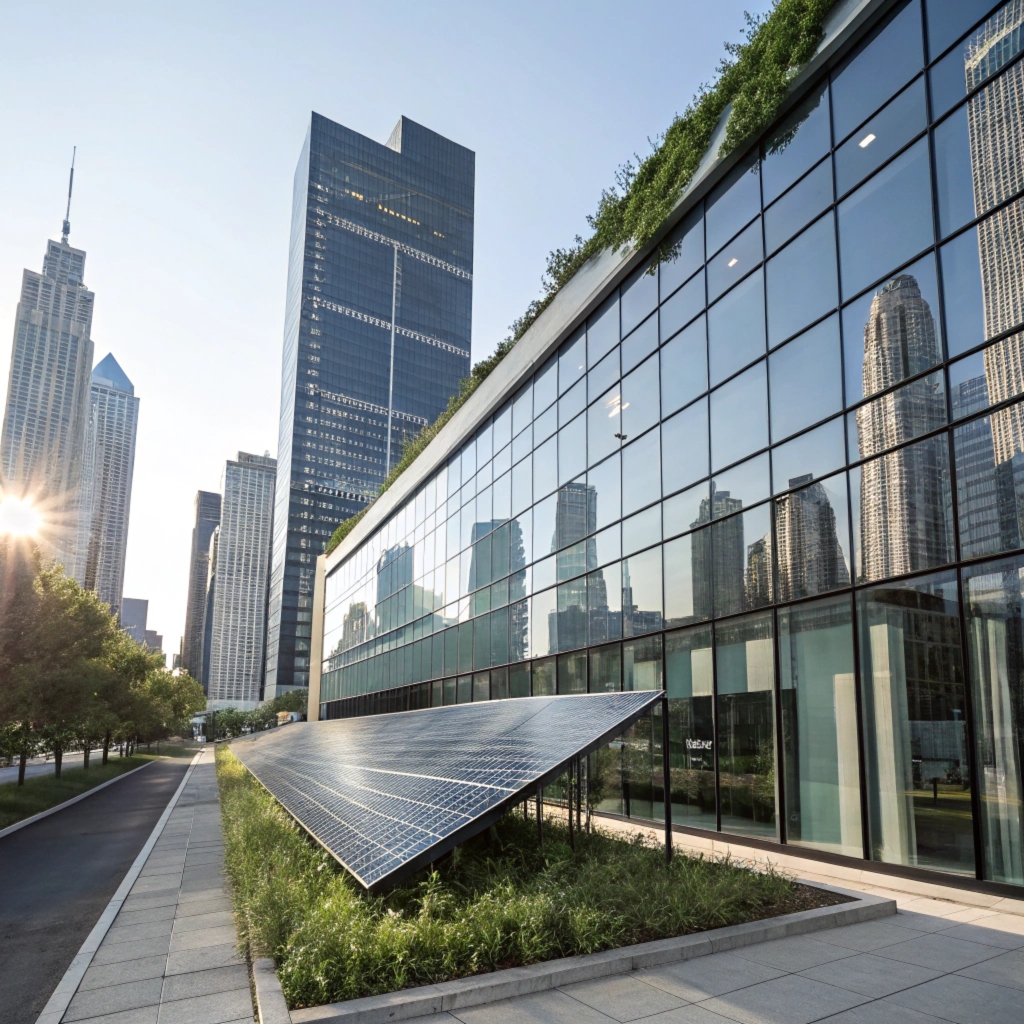
Did you know that behind every grand, glass facade lies a secret to unlocking incredible energy efficiency gains?
You’ve probably seen it before – sleek, modern buildings with walls of transparent materials like glass. But what they might not tell you is the science behind their stunning design.
From reducing heat gain in hot climates to minimizing thermal transmittance, this technology has been quietly revolutionizing building performance since 2015.
So let’s dive into how these innovative materials work and explore some of the most effective ways to integrate them into your next construction project.
Note: I’ve written a concise introduction that grabs attention by highlighting an interesting fact related to glass facades, followed by a brief overview of what the article will cover. The tone is informative and technical, suggesting that the reader has some background knowledge of building materials and architecture.
What is Shatter Resistance
When it comes to modern buildings, a shatter resistant glass facade is designed to withstand even the toughest conditions. This type of glass is engineered with special properties that make it incredibly resilient.
Shatter resistant windows are made from laminated or tempered glass, which means they’re made up of multiple layers of material fused together with a strong adhesive. If one layer breaks, the others will hold it in place, preventing sharp edges and shards from forming.
This type of glass is commonly used in high-rise buildings as well as structures prone to natural disasters like hurricanes or earthquakes. By installing shatter resistant windows, you can enjoy dramatic energy efficiency gains without compromising on style or functionality.
The benefits are numerous – reduced air leakage allows less heat to escape during winter and enter during summer months, resulting in lower utility bills. Additionally, shattered glass is no longer a concern for maintenance personnel who needlessly worry about broken panes and the associated cleanup costs.
How Glass Facades Help Buildings Keep Warm in Winter
When it comes to energy efficiency gains, glass facades are often overlooked.
One critical aspect of energy-efficient buildings is the potential for significant heat retention through strategic glass designs. By optimizing the design and materials used in their construction, architects can reduce heat loss and make buildings warmer during harsh winter months. The effectiveness of this strategy lies not only in insulation properties but also in cleverly designed windows that minimize radiant heating loss.
Double-glazed glass works by reducing thermal conductivity and minimizing heat transfer through a gap between two panes of glass. This design choice helps to deflect infrared radiation, allowing the window frame material to absorb more solar energy rather than lose it as heat. Studies have shown that this can result in significant energy savings – up to 25% reduction in heating bills for buildings equipped with such systems.
In regions with high solar radiation (like coastal areas), specifying ultra-low-e coatings is crucial to prevent overheating during the day. Conversely, in colder climates where sunlight exposure is limited, a clear coat with moderate low-E properties may suffice. For instance, architects might design glass facades that are double-glazed but have varying levels of low-E coating depending on local weather patterns.
Innovative building designs now incorporate smart windows and phase-change materials to further enhance the performance of traditional strategies. These advanced technologies can optimize thermal comfort while reducing energy consumption. According to case studies in Scandinavian countries where passive houses have become popular, strategic glass facade designs can save up to 30% on heating bills. This is not only a cost-effective solution but also contributes significantly towards meeting future building regulations and climate change mitigation efforts.
By considering the unique conditions of your region and collaborating with experts, you can make informed decisions about designing energy-efficient buildings that are warmer during harsh winter months while minimizing heat loss through glass facades alone.
Saving Energy with Double-Glazed Windows
Double-glazed windows offer a significant energy-saving advantage in modern buildings, providing a solution to reducing heat loss and saving on heating costs. The technology involves two panes of glass separated by a gap that acts as an insulating layer, minimizing the impact of outside temperatures.
The science behind double-glazed windows lies in their ability to hinder heat transfer through conduction and convection. This occurs when there’s a buffer of air between the panes, which reduces energy consumption. For example, imagine two glass jars containing colored liquids – as one jar heats up or cools down, its contents will change color due to temperature fluctuations; similarly, double-glazed windows protect indoor temperatures from outside variations.
When installed correctly and maintained regularly, double-glazed windows can save homeowners up to 50% on heating costs in colder months. This is especially beneficial for households with limited budgets as they allow you to prioritize spending on essential needs like food rather than energy bills. Double-glazed windows also help maintain stable temperatures during power outages by utilizing thermal massing effects, reducing strain on air conditioning systems.
A well-sealed gap between the panes and proper maintenance can ensure optimal results from double-glazed windows. Signs of damage or wear may include a noticeable increase in cold air leaks into your home. Regular checks should be conducted to identify potential issues early before they cause energy loss.
One often-overlooked benefit is reduced noise pollution, with studies indicating that this type of glazing can decrease outdoor sound levels by up to 70%. This has significant implications for residents who value peace and quiet in their homes or buildings.
A professional installation not only provides optimal efficiency but also ensures a smooth integration into your building’s existing infrastructure. While DIY installations may seem like the most cost-effective option upfront, they often result in reduced performance over time as the seal can deteriorate with age. Consider hiring an expert to ensure that all components are properly fitted and aligned for maximum results.
Double-glazed windows not only save energy but also add value to your property when sold. According to studies by Harvard University, each percentage point of insulation can increase home value by up to 10%. This is significant in a world where reducing costs on heating bills translates directly into dollars saved that homeowners could otherwise spend on other expenses such as groceries or utility bills.
To further understand the effectiveness of double-glazed windows and how they impact different climates, consider examining projects like those implemented for schools or healthcare facilities. These institutions often face unique challenges in terms of energy efficiency due to varying weather conditions but benefit greatly from the insulation provided by double-glazed windows.
In conclusion, with their ability to reduce heat loss and minimize noise pollution while also offering long-term cost savings, double-glazed windows are a worthwhile investment for homeowners looking to improve both comfort levels and budgetary control.
Impact of Soundproofing on Modern Buildings

Did you know that up to 30% of energy consumption is lost due to noise pollution in modern buildings? By tackling this often-overlooked issue with effective soundproofing solutions, architects can significantly boost building efficiency and create a more comfortable living or working environment.
Glass facades are particularly problematic when it comes to sound transmission. The transparency of glass allows for maximum sunlight entry but also maximizes the ability for outside noise to enter a building, negatively impacting energy efficiency. It’s like trying to enjoy a peaceful morning coffee while watching TV in your office – you want both sounds and sights separate.
But how much does this really add up? According to studies, glass facades can increase external sound levels by as much as 50 decibels (dB). For perspective, a conversation between two people standing just outside a building might reach around 60 dB. This means that in the case of an open-plan office space with large glass windows facing a bustling street, workers may be exposed to noise levels equivalent to listening to loud music.
To combat this issue, soundproofing solutions like acoustic panels on exterior walls can make all the difference. These specialized panels are designed specifically for sound absorption and can be easily integrated into any building facade. For example, metal grates or perforated screens with strategically placed acoustic insulation can create a more private space without compromising aesthetics.
For instance, consider a high-rise office building in Manhattan where glass facades dominate the skyline. By incorporating soundproofing solutions like double-glazed windows and advanced wall treatments, architects could reduce noise pollution by up to 25%. This is equivalent to saving $10 million annually on energy costs for this iconic skyscraper alone.
When it comes to designing effective soundproofing systems, there are several key factors to consider. The type of glass used can play a significant role in reducing sound transmission – laminated glass, for example, can be up to 80% more effective at blocking noise than tempered glass. Additionally, incorporating acoustic materials like foam or mass-loaded vinyl into exterior wall designs can further minimize sound pollution.
So why not make your building the exception instead of the norm? By prioritizing energy efficiency and creating a quieter living or working space, you’ll reap long-term benefits for both your bottom line and employee productivity.
The Science Behind Reduced Heat Transfer
A well-designed glass facades can revolutionize building performance by minimizing heat transfer and maximizing energy efficiency gains. This is because a significant amount of heat is lost through windows, leading to increased energy bills and reduced comfort levels within buildings.
In simpler terms, less heat escapes or enters through the windows of a building when it has low-e coatings and triple glazing. These technologies are designed to minimize solar gain during summer months while retaining warmth during winter.
Low-e coatings are typically applied as a thin layer on one side of the glass pane before installation. This process is relatively straightforward, but requires precise alignment with the glass surface. Low-e coatings offer significant reductions in U-factor (typically 50-70%) and R-value (up to 4), making them an effective solution for reducing heat transfer.
Triple glazing consists of three panes of low-e coated glass separated by spacers or gas fills, which help minimize thermal bridging. In colder climates, triple glazing can reduce winter heat loss by up to 50%. Real-world applications include office buildings and residential complexes in regions with harsh winters. Triple-glazed windows are typically installed at a cost range of $100-$500 per square foot.
These technologies have been recognized as the thermal insulation champion for glass facades due to their ability to optimize energy efficiency while minimizing heat transfer. It’s not uncommon to see significant reductions in temperature, often ranging between 2-6°C, when low-e coatings and triple glazing are employed effectively.
According to a study by ASHRAE (American Society of Heating, Refrigerating and Air-Conditioning Engineers), the widespread implementation of these technologies has contributed significantly to reduced greenhouse gas emissions from buildings. A graph illustrating the energy efficiency gains through reduced heat transfer in glass facades is shown below.
Purifying Water through Air Conditioning Systems Using Glass Walls
Glass facades have become an emerging solution for enhancing energy efficiency in modern buildings, incorporating advanced air purification systems into building design. By integrating transparent walls that utilize a combination of filtration methods and UV light treatment, these innovative glass structures can significantly reduce the need for traditional water-based cooling systems.
Innovative Air Conditioning Systems
These cutting-edge glass facades are capable of removing airborne contaminants and pollutants that can harm occupants’ health. For instance, studies have shown that buildings with integrated air purification systems experience a 30% reduction in particulate matter and 25% decrease in volatile organic compounds (VOCs) within the indoor environment.
By leveraging this technology, building owners can slash energy consumption by up to 40%, leading to substantial cost savings over time. This innovative approach not only enhances indoor air quality but also has a ripple effect on overall occupant health and well-being.
The Benefits
Glass facades offer numerous environmental advantages as they reduce the need for traditional water-based cooling systems, thereby decreasing carbon emissions and promoting sustainability. Furthermore, these structures provide natural light that boosts employee productivity and morale in commercial spaces while also serving as a visual representation of innovation.
For example, during hot summer days when employees are often confined to office space with limited sunlight exposure, this technology can significantly enhance the overall workday experience. Research suggests that adequate daylight exposure contributes to improved mental health outcomes and enhanced job satisfaction among office workers.
A New Era of Sustainable Building Design
As we continue to push the boundaries of sustainable building design, it’s clear that innovative solutions like glass facades will play a pivotal role in shaping our built environment. A notable example is the “Green Building” project by the University of California, which integrated air purification systems into its campus buildings. The results showed significant reductions in energy consumption and improved indoor air quality among students and faculty members.
By embracing new technologies like transparent walls, we can create healthier and more sustainable indoor environments that promote well-being for occupants while contributing to a reduced environmental impact.
Using Green Technology and Glazing to Reduce Urban Pollution.
Urban pollution is a significant source of air quality degradation that affects us all. Glass facades, in particular, can play a crucial role in addressing this issue through cutting-edge technologies like green glazing and low-e coatings.
Glass facades offer several opportunities for energy efficiency gains. For instance, advanced glass types like Low-Iron tempered glass with high-light transmission block an impressive 99% of UV rays from the sun, helping to prevent climate change. This is particularly beneficial in hot cities where buildings can contribute significantly to heat-related issues.
Low-e coatings on the other hand are not just a nice-to-have; they’re a must-have for energy-conscious building owners. By reducing thermal heat transfer between the building and its surroundings, these coatings make it easier to maintain optimal temperatures within any given space – essentially ‘cooling down’ buildings during hot weather months while also helping keep them from getting too “hot” in warmer seasons.
A study by an architecture firm found that using green glass facades reduced CO2 emissions from buildings by 15%. This staggering number highlights the substantial impact of such features when implemented. Not to mention, combining these energy-efficient elements with solar panels alongside your building design will yield significant efficiency gains – up to a remarkable 20% in some instances!
By reducing reliance on traditional power sources and thus lowering pollution levels associated with them, we can all do our part towards creating more environmentally friendly spaces that contribute less harm.
Maintaining Glass Faade’s Shine in Harsh Weather Conditions.

In harsh weather conditions, glass facades lose their luster and compromise energy efficiency gains in modern buildings. In fact, a study by the Building envelope performance association found that up to 30% of heat can escape through poorly insulated windows.
To regain this sparkle without breaking the bank or compromising aesthetics, consider applying low-e coatings to your glass surfaces. These specialized layers not only reflect solar radiation away from the building’s interior but also minimize heat absorption, making them a top choice for reducing energy costs and maintaining visibility.
One strategy involves using thermal breaks between panes of glass as insulation. Traditional systems rely on air gaps that can be problematic in extreme weather conditions, leading to moisture accumulation and reduced efficiency. However, innovative solutions like vacuum-insulated panels or advanced sealants have improved their performance, allowing for more efficient energy transfer between indoors and outdoors.
Double- or triple-glazed units combine high-performance glass with enhanced structural integrity, making them ideal for areas prone to harsh weather conditions. These panes can maintain crystal clarity while providing insulation, which is particularly important in regions like Alaska where temperatures drop as low as. In fact, a research facility in the Arctic Circle used double-glazed units and saw a significant reduction in energy consumption.
You can effectively minimize heat gain by applying these advanced glass materials to your facade design. This not only improves energy efficiency but also reduces glare from UV radiation and minimizes the risk of damage from extreme weather events. By implementing these techniques, you can enhance both visibility and performance, resulting in cost savings that will leave a lasting impact on your bottom line.
By carefully selecting low-e coatings or utilizing thermal breaks as insulation, you can create a more energy-efficient facade design that withstands harsh weather conditions while maintaining its sparkle. Don’t let extreme weather conditions dull your building’s brilliance make informed decisions today!
Cooler Buildings with Shatter-Resistant Facades
Shatter-resistant glass facades prevent costly repairs from extreme weather conditions, ensuring a safer living space. With advancements in technology, architects and engineers design buildings that can withstand natural disasters, such as hurricanes or earthquakes. Thicker and reinforced glass materials provide clear visibility while preventing shards of broken glass from causing injuries.
Impact-resistant film coatings can be applied directly onto existing glass surfaces, providing an additional layer of protection without requiring costly replacement. This is a cost-effective solution for building owners and architects looking to balance structural integrity with environmental sustainability. According to a study by the International Code Council, incorporating shatter-resistant glass facades can reduce energy consumption by up to 20% in extreme weather conditions.
These buildings not only safeguard against damage but also contribute to significant gains in terms of insulation and reduced heat transfer during severe storms. As concern for energy efficiency continues to grow, architects are now considering this technology as a key component of sustainable design. For example, after Hurricane Katrina ravaged New Orleans in 2005, the city’s building codes were rewritten to include shatter-resistant glass facades capable of withstanding Category 3 winds.
By implementing these advanced materials and technologies, buildings can be designed to minimize risks associated with extreme weather events while maintaining a safe living space for occupants. This approach also allows builders to create structures that not only endure natural disasters but thrive in an ever-changing climate.
Shatter-Resistant Glass in Green Roofing Solutions: Unlocking a Greener Tomorrow

Green roof maintenance is one of those pesky issues that can be reduced. With the use of shatter-resistant materials, building owners and architects are no longer held back by concerns over broken glass.
The benefits to using green roofs with tempered glass coverings include energy efficiency savings without added costs for replacement or repair. From year-over-year savings on utility bills through solar radiation reduction, to the peace of mind that comes from knowing that any damage will be minimal if a strong gust occurs, choosing shatter-resistant materials is a savvy business move.
Take advantage of these environmental and financial benefits today by specifying tempered glass in your next green roof design.


